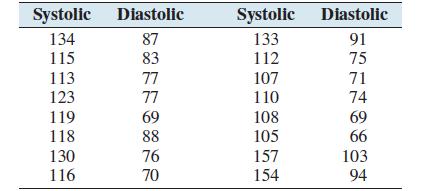A blood pressure measurement consists of two numbers: the systolic pressure, which is the maximum pressure taken
Question:
A blood pressure measurement consists of two numbers: the systolic pressure, which is the maximum pressure taken when the heart is contracting, and the diastolic pressure, which is the minimum pressure taken at the beginning of the heartbeat. Blood pressures were measured, in millimeters, for a sample of 16 adults. The following table presents the results.
a. Compute the least-squares regression line for predicting diastolic pressure (y) from systolic pressure (x).
b. Construct a 99% confidence interval for the slope.
c. Test H0: β1 = 0 versus H1: β1 > 0.
Can you conclude that systolic blood pressure is useful in predicting diastolic blood pressure? Use the α = 0.01 level of significance.
d. Do people with higher diastolic pressure tend to have higher or lower systolic pressures? Explain.
Step by Step Answer:






